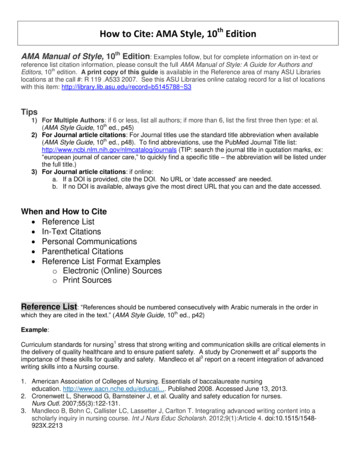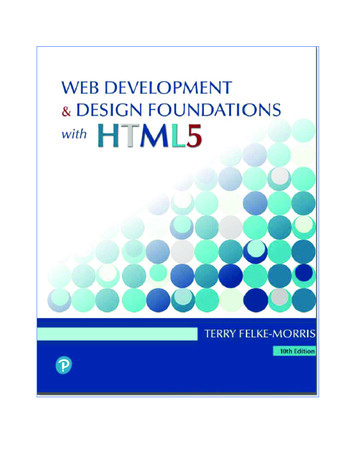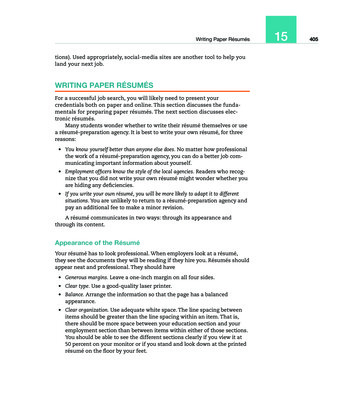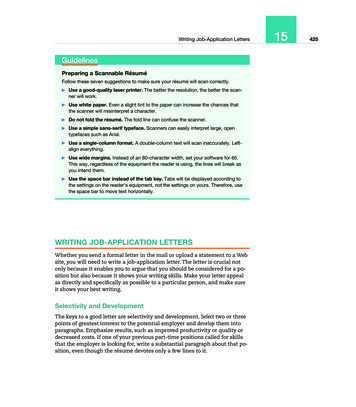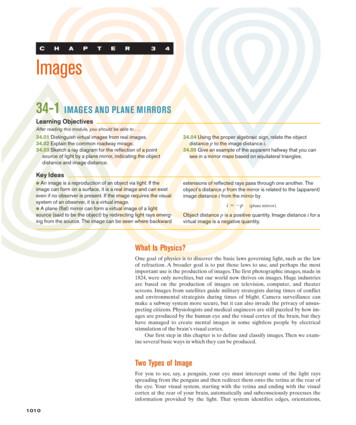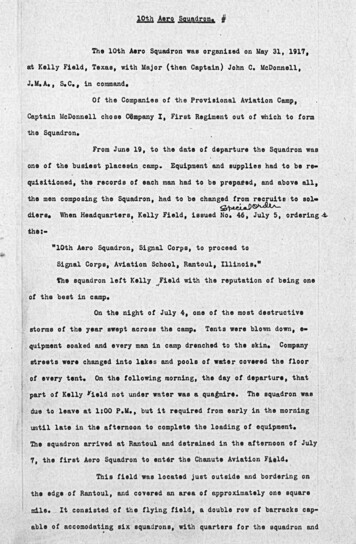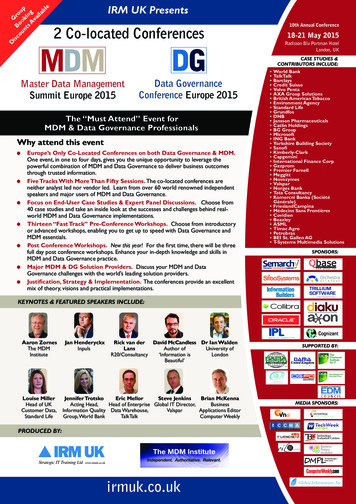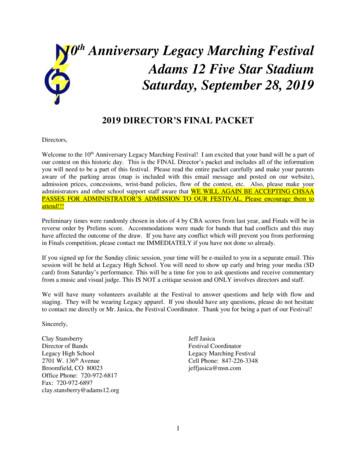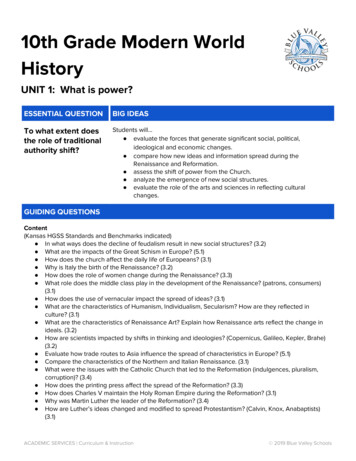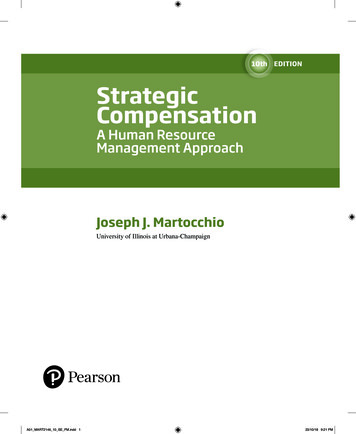
Transcription
10thEDITIONStrategicCompensationA Human ResourceManagement ApproachJoseph J. MartocchioUniversity of Illinois at Urbana-ChampaignA01 MART2146 10 SE FM.indd 123/10/18 9:21 PM
In Loving Memory of Orlando “Lundy” MartocchioVice President, Business, Economics, and UKCourseware: Donna BattistaDirector of Portfolio Management: Stephanie WallDirector, Courseware Portfolio Management:Ashley DodgeSenior Sponsoring Editor: Neeraj BhallaEditorial Assistant: Linda AlbelliVice President, Product Marketing: RoxanneMcCarleySenior Product Marketer: Becky BrownProduct Marketing Assistant: Marianela SilvestriManager of Field Marketing, Business Publishing:Adam GoldsteinField Marketing Manager: Nicole PriceVice President, Production and Digital Studio, Artsand Business: Etain O’DeaDirector, Production and Digital Studio, Businessand Economics: Ashley SantoraManaging Producer, Business: Melissa FeimerSenior Content Producer: Sugandh JunejaContent Producer: Shweta JainOperations Specialist: Carol MelvilleDesign Lead: Kathryn FootManager, Learning Tools: Brian SuretteLearning Tools Strategist: Michael TrinchettoManaging Producer, Digital Studio and GLP: James BatemanManaging Producer, Digital Studio: Diane LombardoDigital Studio Producer: Regina DaSilvaDigital Studio Producer: Alana ColesFull Service Project Management: Bhanuprakash Sherla,Pearson CSCInterior Design: Pearson CSCCover Design: Pearson CSCCover Art: Gary Waters/Ikon Images/Alamy Stock PhotoPrinter/Binder: LSC Communications, Inc., KendallvilleCover Printer: Phoenix Color/HagerstownMicrosoft and/or its respective suppliers make no representations about the suitability of the information contained in thedocuments and related graphics published as part of the services for any purpose. All such documents and related graphicsare provided “as is” without warranty of any kind. Microsoft and/or its respective suppliers hereby disclaim all warrantiesand conditions with regard to this information, including all warranties and conditions of merchantability, whether express,implied or statutory, fitness for a particular purpose, title and non-infringement. In no event shall Microsoft and/or its respectivesuppliers be liable for any special, indirect or consequential damages or any damages whatsoever resulting from loss of use,data or profits, whether in an action of contract, negligence or other tortious action, arising out of or in connection with the useor performance of information available from the services.The documents and related graphics contained herein could include technical inaccuracies or typographical errors. Changes areperiodically added to the information herein. Microsoft and/or its respective suppliers may make improvements and/or changesin the product(s) and/or the program(s) described herein at any time. Partial screen shots may be viewed in full within thesoftware version specified.Microsoft and Windows are registered trademarks of the Microsoft Corporation in the U.S.A. and other countries. This bookis not sponsored or endorsed by or affiliated with the Microsoft Corporation.Copyright 2020, 2017, 2015 by Pearson Education, Inc. or its affiliates. All Rights Reserved. Manufactured in the UnitedStates of America. This publication is protected by copyright, and permission should be obtained from the publisher prior toany prohibited reproduction, storage in a retrieval system, or transmission in any form or by any means, electronic, mechanical,photocopying, recording, or otherwise. For information regarding permissions, request forms, and the appropriate contactswithin the Pearson Education Global Rights and Permissions department, please visit www.pearsoned.com/permissions/.Acknowledgments of third-party content appear on the appropriate page within the text.PEARSON, ALWAYS LEARNING, and MYLAB are exclusive trademarks owned by Pearson Education, Inc. or its affiliates inthe U.S. and/or other countries.Unless otherwise indicated herein, any third-party trademarks, logos, or icons that may appear in this work are the property oftheir respective owners, and any references to third-party trademarks, logos, icons, or other trade dress are for demonstrative ordescriptive purposes only. Such references are not intended to imply any sponsorship, endorsement, authorization, or promotionof Pearson’s products by the owners of such marks, or any relationship between the owner and Pearson Education, Inc., or itsaffiliates, authors, licensees, or distributors.Library of Congress Cataloging-in-Publication DataNames: Martocchio, Joseph J., author.Title: Strategic compensation : a human resource management approach / JosephJ. Martocchio, University of Illinois at Urbana-Champaign.Description: Tenth edition. Boston : Pearson Education, [2020]Identifiers: LCCN 2018038833 ISBN 9780135192146 (print) ISBN 0135192145(print)Subjects: LCSH: Compensation management.Classification: LCC HF5549.5.C67 M284 2020 DDC 658.3/22--dc23 LC record available at https://lccn.loc.gov/2018038833118ISBN 10: 0-13-519214-5ISBN 13: 978-0-13-519214-6A01 MART2146 10 SE FM.indd 223/10/18 9:21 PM
Brief ContentsPart ISetting the Stage for Strategic Compensation1Chapter 1Strategic Compensation:A Component of Human Resource SystemsChapter 2Contextual Influences on Compensation PracticePart II228Bases for Pay 57Chapter 3Traditional Bases for Pay: Seniority and MeritChapter 4Incentive Pay 84Chapter 5Person-Focused Pay 109Part III Designing Compensation Systems58129Chapter 6Building Internally Consistent Compensation Systems130Chapter 7Building Market-Competitive Compensation Systems156Chapter 8Building Pay Structures that Recognize EmployeeContributions 181Part IV Employee BenefitsChapter 9Chapter 10Part V211Discretionary Benefits212Legally Required Benefits239Contemporary Strategic Compensation ChallengesChapter 11Compensating ExecutivesChapter 12Compensating the Flexible Workforce: ContingentEmployees and Flexible Work Schedules 293264Part VI Compensation Issues Around the World319Chapter 13Compensating ExpatriatesChapter 14Pay and Benefits Outside the United StatesEpilogueEpilogue263320340359Challenges Facing Compensation Professionals360iiiA01 MART2146 10 SE FM.indd 323/10/18 9:21 PM
ContentsPrefacePart IXVSetting the Stage for Strategic CompensationChapter 11Strategic Compensation: A Component of Human ResourceSystems 2Defining Strategic Compensation3What Is Compensation? 3What Is Strategic Compensation? 4Compensation as a Strategic Business PartnerStrategic Compensation Decisions 65Competitive Business Strategy Choices 7Compensation Decisions that Support the Firm’s Strategy 7Employee Roles Associated with Competitive Strategies 8Building Blocks and Structure of Strategic Compensation Systems8Building Blocks: Core Compensation and Employee Benefits 9Fundamental Compensation System Design Elements 11Alternative Pay Structure Configurations 14Fitting the Compensation Function in an Organization’s Structure 14How HR Professionals Fit into the Corporate Hierarchy 14The Compensation Profession 15How the Compensation Function Fits into HR Departments 15Stakeholders of the Compensation System18Employees 19Line Managers 19Executives 19Unions 19U.S. Government 19Developing Skills for your Career 20Communication 20Critical Thinking 20Collaboration 20Knowledge Application and Analysis 21Business Ethics and Social Responsibility 21Information Technology Application and Computing Skills 21Data Literacy 21PREPARING FOR EXAMS/QUIZZES 22Chapter Summary by Learning Objectives 22 Key Terms 23 Discussion Questions 23PREPARING FOR MY CAREER 23 COMPENSATION IN ACTION 23 CASE 1: Competitive Strategy at Sportsman Shoes 24 CASE 2: Ethics Dilemma: Profits at any Cost 25 CRUNCH THE NUMBERS! Calculating the Costs of Increasing the TotalCompensation Budget at Butcher Enterprises 25ivA01 MART2146 10 SE FM.indd 423/10/18 9:21 PM
Contents v WORKING TOGETHER: Team Exercise Endnotes 26Chapter 226Contextual Influences on Compensation Practice28Interindustry Wage Differentials 29Pay Differentials Based on Occupational Characteristics 31Geographic Pay Differentials 33Labor Unions 34Employment Laws Pertinent to Compensation Practice 37Income Continuity, Safety, and Work Hours 37Pay Discrimination 42Civil Rights Act of 1964 44Accommodating Disabilities and Family Needs 47Prevailing Wage Laws 48PREPARING FOR EXAMS/QUIZZES 49Chapter Summary by Learning Objectives 49 Key Terms 50 Discussion Questions 50PREPARING FOR MY CAREER 50 COMPENSATION IN ACTION 50 CASE 1: Take it or Leave it 51 CASE 2: Ethics Dilemma: Perpetuating the Gender Pay Gap at Safe SecurityAlarm Systems 52 CRUNCH THE NUMBERS! Comparison of Compensation and Benefits Costs inUnion and Nonunion Settings 52 WORKING TOGETHER: Team Exercise 53 Endnotes 53Part IIBases for PayChapter 357Traditional Bases for Pay: Seniority and MeritSeniority and Longevity Pay5858Historical Overview 59Who Participates? 60Effectiveness of Seniority Pay Systems 60Design of Seniority Pay and Longevity Pay Plans 60Advantages of Seniority Pay 63Fitting Seniority Pay with Competitive Strategies 63Merit Pay 64Who Participates? 64Exploring the Elements of Merit Pay 64Performance Appraisal65Types of Performance Appraisal Plans 67Exploring the Performance Appraisal Process 71Are Traditional Performance Appraisal Methods Becoming Irrelevant? 74Strengthening the Pay-For-Performance LinkLink Performance Appraisals to Business GoalsAnalyze Jobs 75Communicate 75Establish Effective Appraisals 75A01 MART2146 10 SE FM.indd 5747523/10/18 9:21 PM
vi ContentsEmpower Employees 75Differentiate Among Performers75Possible Limitations of Merit Pay Programs 76Failure to Differentiate among Performers 76Poor Performance Measures 76Supervisors’ Biased Ratings of Employee Job Performance 77Lack of Open Communication between Management and Employees 77Undesirable Social Structures 77Mounting Costs 77Factors Other than Merit 77Undesirable Competition 78Little Motivational Value 78PREPARING FOR EXAMS/QUIZZES 78Chapter Summary by Learning Objectives 78 Key Terms 79 Discussion Questions 79PREPARING FOR MY CAREER 79 COMPENSATION IN ACTION 79 CASE 1: The Dreaded Performance Appraisal 80 CASE 2: Ethics Dilemma: Pay for Performance Disconnect 81 CRUNCH THE NUMBERS! Determining Pay Increases in JobClassification Plans 81 WORKING TOGETHER: Team Exercise 81 Endnotes 82Chapter 4Incentive Pay84Exploring Incentive Pay 84Contrasting Incentive Pay with Traditional PayIndividual Incentives 8785Defining Individual Incentives 88Types of Individual Incentive Plans 88Advantages of Individual Incentive Pay Programs 91Disadvantages of Individual Incentive Pay Programs 91Group Incentives 92Defining Group Incentives 93Types of Group Incentive Plans 93Advantages of Group Incentives 97Disadvantages of Group Incentives 98Company-Wide Incentives 99Defining Company-wide Incentives 99Types of Company-wide Incentive Plans 99Designing Incentive Pay Programs101Group versus Individual Incentives 101Level of Risk 102Complementing or Replacing Base Pay 102Performance Criteria 102Time Horizon: Short Term versus Long Term 103PREPARING FOR EXAMS/QUIZZES 103Chapter Summary by Learning ObjectivesDiscussion Questions 104A01 MART2146 10 SE FM.indd 6103 Key Terms 104 23/10/18 9:21 PM
Contents vii PREPARING FOR MY CAREER 104 COMPENSATION IN ACTION 104 CASE 1: Individual or Team Reward? 105 CASE 2: Ethics Dilemma: Incentive Pay Gone Wrong 106 CRUNCH THE NUMBERS! Calculating Profit Sharing Pay Awards WORKING TOGETHER: Team Exercise 106 Endnotes 107Chapter 5106Person-Focused Pay 109Defining Person-Focused Pay: Pay-For-Knowledge, Skill-Based Pay, andCompetency-Based Pay 109Knowledge-Based Pay and Skill-Based Pay 110Competency-Based Pay and the Competency Model Clearinghouse 111Usage of Person-Focused Pay Programs 112Reasons to Adopt Person-Focused Pay Programs 114Varieties of Person-Focused Pay Programs 116Contrasting Person-Focused Pay with Job-Based Pay 120Advantages and Disadvantages of Person-Focused Pay Programs121Advantages 121Disadvantages 123PREPARING FOR EXAMS/QUIZZES 124Chapter Summary by Learning Objectives 124 Key Terms 124 Discussion Questions 125PREPARING FOR MY CAREER 125 COMPENSATION IN ACTION 125 CASE 1: Person-Focused Pay at Mitron Computers 125 CASE 2: Ethics Dilemma: Limiting Access to Training 126 CRUNCH THE NUMBERS! Hiring a Mix of Entry-Level Workers and SkilledCandidates under a Skill-Based Pay Program 126 WORKING TOGETHER: Team Exercise 127 Endnotes 127Part III Designing Compensation SystemsChapter 6129Building Internally Consistent Compensation SystemsInternal ConsistencyJob Analysis 132Steps in the Job Analysis Process 132Legal Considerations for Job Analysis 137Job Analysis Techniques 138Occupational Information Network (O*NET)Job Evaluation130130138142Compensable Factors 142The Job Evaluation Process 144Job Evaluation Techniques145The Point Method 146Alternative Job-Content Evaluation ApproachesAlternatives to Job Evaluation 150A01 MART2146 10 SE FM.indd 714923/10/18 9:21 PM
viii ContentsInternally Consistent Compensation Systems and Competitive Strategy150PREPARING FOR EXAMS/QUIZZES 151Chapter Summary by Learning Objectives 151 Key Terms 151 Discussion Questions 152PREPARING FOR MY CAREER 152 COMPENSATION IN ACTION 152 CASE 1: Job Evaluation at Smith Upholstery 153 CASE 2: Ethics Dilemma: Stop Complaining or Else 154 CRUNCH THE NUMBERS! Modifying a Job Evaluation Worksheet 154 WORKING TOGETHER: Team Exercise 155 Endnotes 155Chapter 7Building Market-Competitive Compensation Systems156Market-Competitive Pay Systems: The Basic Building Blocks 156Compensation Surveys 157Preliminary Considerations 157Using Published Compensation Survey Data 158Compensation Surveys: Strategic Considerations 161Compensation Survey Data 163Updating the Survey Data 170Integrating Internal Job Structures With External MarketPay Rates 170Compensation Policies And Strategic Mandates 173Pay Level Policies 173Pay Mix Policies 174PREPARING FOR EXAMS/QUIZZES 175Chapter Summary by Learning Objectives 175 Key Terms 176Discussion Questions 176PREPARING FOR MY CAREER 176 COMPENSATION IN ACTION 176 CASE 1: Nutriment’s New Hires 177 CASE 2: Ethics Dilemma: A Slanted Wage Proposal 178 CRUNCH THE NUMBERS! Updating Salary Survey Data 179 WORKING TOGETHER: Team Exercise 179 Endnotes 180Chapter 8 Building Pay Structures that Recognize EmployeeContributions 181Constructing a Pay Structure 181Step 1: Deciding on the Number of Pay Structures 182Step 2: Determining a Market Pay Line 183Step 3: Defining Pay Grades 183Step 4: Calculating Pay Ranges for Each Pay Grade 183Step 5: Evaluating the Results 188Designing Merit Pay Systems 189Merit Increase Amounts 190Timing 191Recurring versus Nonrecurring Merit Pay Increases 191A01 MART2146 10 SE FM.indd 823/10/18 9:21 PM
Contents ix Present Level of Base Pay 191Rewarding Performance: The Merit Pay GridMerit Pay Increase Budgets 193191Designing Sales Incentive Compensation Plans195Alternative Sales Compensation Plans 195Sales Compensation Plans and Competitive Strategy 197Determining Fixed Pay and the Compensation Mix 198Designing Person-Focused ProgramsEstablishing Skill Blocks 199Transition Matters 200Training and Certification 201In-House or Outsourcing TrainingPay Structure VariationsBroadbanding 202Two-Tier Pay Structures199201202204PREPARING FOR EXAMS/QUIZZES 205Chapter Summary by Learning Objectives 205 Key Terms 206 Discussion Questions 206PREPARING FOR MY CAREER 206 COMPENSATION IN ACTION 206 CASE 1: A New Sales Representative 207 CASE 2: Ethics Dilemma: Arbitrary Compa-ratios 208 CRUNCH THE NUMBERS! Calculating Pay Range Minimums, Maximums, andPay Range Overlap 208 WORKING TOGETHER: Team Exercise 209 Endnotes 209Part IV Employee BenefitsChapter 9211Discretionary Benefits212Origins of Discretionary Benefits 212Categories of Discretionary Benefits 214Protection Programs 214Paid Time Off 219Services 222Legislation Pertinent to Discretionary Benefits226Internal Revenue Code 226Employee Retirement Income Security Act of 1974 (ERISA) 226Pension Protection Act of 2006 228Designing and Planning the Benefits ProgramDetermining Who Receives CoverageFinancing 229Employee Choice 229Cost Containment 229Communication 230A01 MART2146 10 SE FM.indd 9228229The Benefits and Costs of Discretionary Benefits231PREPARING FOR EXAMS/QUIZZES 232Chapter Summary by Learning ObjectivesDiscussion Questions 234 232Key Terms 233 23/10/18 9:21 PM
x ContentsPREPARING FOR MY CAREER 234 COMPENSATION IN ACTION 234 CASE 1: Employee Benefits that Matter 235 CASE 2: Ethics Dilemma: A Poor Bid 235 CRUNCH THE NUMBERS! Calculating Employer Matching Contributions WORKING TOGETHER: Team Exercise 236 Endnotes 237Chapter 10Legally Required Benefits236239Origins of Legally Required Benefits 239Categories of Legally Required Benefits 240Social Security Programs 240Workers’ Compensation 245Family and Medical Leave 246State and Local Paid Leave Laws 247Health Insurance 248Health Insurance Program Design Alternatives 249Fee-For-Service Plans 250Managed-Care Approach 251Features of Health Care Plans 252Specialized Insurance Benefits 253Consumer-Driven Health Care 254Additional Health Care Legislation 255Consolidated Omnibus Budget Reconciliation Act of 1985 (COBRA) 255Health Insurance Portability and Accountability Act of 1996 (HIPAA) 256The Benefits and Costs of Legally Required Benefits 256PREPARING FOR EXAMS/QUIZZES 258Chapter Summary by Learning Objectives 258 Key Terms 258 Discussion Questions 259PREPARING FOR MY CAREER 259 COMPENSATION IN ACTION 259 CASE 1: Social Security and Retirement Planning at Taylor Foods 260 CASE 2: Ethics Dilemma: Go with the High-Deductible Health Plan 261 CRUNCH THE NUMBERS! Calculating Federal Insurance Contributions Act(FICA) Taxes 261 WORKING TOGETHER: Team Exercise 262 Endnotes 262Part V Contemporary Strategic Compensation Challenges 263Chapter 11Compensating Executives264Contrasting Executive Pay with Pay for Nonexecutive Employees 264Defining Executive Status 265Who are Executives? 265Key Employees 265Highly Compensated Employees267Executive Compensation Packages 267Components of Current Core Compensation 267Components of Deferred Core Compensation 269A01 MART2146 10 SE FM.indd 1023/10/18 9:21 PM
Contents xi Equity Agreements 269Separation Agreements 271Clawback Provisions 272Employee Benefits: Enhanced Protection Program Benefits and Perquisites 272Principles and Processes for Setting Executive Compensation274The Key Players in Setting Executive Compensation 274Theoretical Explanations for Setting Executive Compensation 275Executive Compensation Disclosure Rules276Securities and Exchange Act of 1934 277Wall Street Reform and Consumer Protection Act of 2010 ( Dodd-Frank Act)279Executive Compensation: Are U.S. Executives Paid too Much? 282Comparison between Executive Compensation and Compensation for Other WorkerGroups 282Strategic Questions: Is Pay for Performance? 282Ethical Considerations: Is Executive Compensation Fair? 283International Competitiveness 284PREPARING FOR EXAMS/QUIZZES 286Chapter Summary by Learning Objectives 286 Key Terms 286 Discussion Questions 287PREPARING FOR MY CAREER 287 COMPENSATION IN ACTION 287 CASE 1: Building an Executive Compensation Package 288 CASE 2: Ethics Dilemma: Resistance to Clawback CEO Severance Pay atUnited Airlines 289 CRUNCH THE NUMBERS! Comparison of Pay Within and AcrossIndustries 289 WORKING TOGETHER: Team Exercise 290 Endnotes 290Chapter 12Compensating the Flexible Workforce: ContingentEmployees and Flexible Work Schedules 293The Contingent Workforce293Groups of Contingent Workers 294Reasons for U.S. Employers’ Increased Reliance on Contingent Workers 299Pay and Employee Benefits for Contingent WorkersPart-Time Employees 301Temporary Employees 302Leased Workers 303Independent Contractors, Freelancers, and Consultants301304Flexible Work Schedules: Flextime, Compressed Workweeks, andTelecommuting 307Flextime Schedules 307Compressed Workweek Schedules 308Telecommuting 308Flexible Work Schedules: Balancing the Demands of Work Life and Home Life 309Pay and Employee Benefits for Flexible Employees 309Pay 309Employee Benefits310Unions’ Reactions to Contingent Workers and Flexible Work Schedules 311A01 MART2146 10 SE FM.indd 1123/10/18 9:21 PM
xii ContentsStrategic Issues and Choices in Using Contingent and Flexible Workers 311PREPARING FOR EXAMS/QUIZZES 312Chapter Summary by Learning Objectives 312 Key Terms 313 Discussion Questions 314PREPARING FOR MY CAREER 314 COMPENSATION IN ACTION 314 CASE 1: Telecommuting at MedEx 315 Case 2: Ethics Dilemma: Cost Savings at the Expense of Employees 315 CRUNCH THE NUMBERS! Calculating the Costs of Full-Time andPart-Time Employment 316 WORKING TOGETHER: Team Exercise 316 Endnotes 317Part VICompensation Issues Around the WorldChapter 13Compensating Expatriates319320Competitive Advantage and How International Activities Fit in 321Lowest-Cost Producers’ Relocations to Cheaper Production Areas 321Differentiation and the Search for New Global Markets 321How Globalization is Affecting HR Departments 322Complexity of International Compensation Programs 323Preliminary Considerations323Host Country Nationals, Third Country Nationals, and Expatriates: Definitions and Relevancefor Compensation Issues 323Term of International Assignment 324Staff Mobility 324Equity: Pay Referent Groups 324Components of International Compensation ProgramsSetting Base Pay for U.S. Expatriates 324324Methods for Setting Base Pay 325Purchasing Power 326Incentive Compensation for U.S. Expatriates 326Foreign Service Premiums 327Hardship Allowances 327Mobility Premiums 328Establishing Employee Benefits for U.S. Expatriates 328Standard Benefits for U.S. Expatriates 329Enhanced Benefits for U.S. Expatriates 330Balance Sheet Approach for U.S. Expatriates’ Compensation Packages331Housing and Utilities 332Goods and Services 333Discretionary Income 333Tax Considerations 333Repatriation Pay Issues 334PREPARING FOR EXAMS/QUIZZES 335Chapter Summary by Learning ObjectivesDiscussion Questions 336PREPARING FOR MY CAREER 336 COMPENSATION IN ACTION 336A01 MART2146 10 SE FM.indd 12335 Key Terms 335 23/10/18 9:21 PM
Contents xiii CASE 1: Jenkins Goes Abroad 337 CASE 2: Ethics Dilemma: Request Approved, then Denied 338 CRUNCH THE NUMBERS! Calculating an Expatriate’s Base Pay andIncentives 338 WORKING TOGETHER: Team Exercise 338 Endnotes 339Chapter 14Pay and Benefits Outside the United States340Pertinent Concepts for Quantifying Economic Elements in the Discussion ofPay and Benefits Outside the United States 341North America 342Canada 343Mexico 344South AmericaEurope 346Asia 348345India 348People’s Republic of China350PREPARING FOR EXAMS/QUIZZES 352Chapter Summary by Learning Objectives 352 Key Terms 352 Discussion Questions 353PREPARING FOR MY CAREER 353 COMPENSATION IN ACTION 353 CASE 1: Expanding Internationally at Suds Microbrewery 354 CASE 2: Ethics Dilemma: Underpaying Workers at Serenity Resorts 354 CRUNCH THE NUMBERS! Comparing the Rates of Change in GDP Per Capitafor S elect Countries 355 WORKING TOGETHER: Team Exercise 356 Endnotes 356Epilogue359EpilogueChallenges Facing Compensation ProfessionalsPossible Increase to the Federal Minimum Wage RateTrends in Performance Appraisal 362The Compensation-Productivity Gap 363Gender Pay Gap 365Pay Transparency 368PREPARING FOR EXAMS/QUIZZES 369Chapter Summary by Learning ObjectivesDiscussion Questions 370 Endnotes 370Glossary Key Terms 370 373Author Index387Subject Index389A01 MART2146 10 SE FM.indd 1336936036123/10/18 9:21 PM
A01 MART2146 10 SE FM.indd 1423/10/18 9:21 PM
PrefaceNEW TO THIS EDITIONStrategic Compensation: A Human Resource Management Approach, Tenth Edition, containssubstantial new content and changes, including the following: Three new features appear in each chapter that enable students to integrate knowledge andvaluable skills regardless of whether they are choosing a career in the compensation profession or other business functions in smaller or larger organizations. Ethics Dilemma. Ethics is the discipline dealingwith what is good and bad, right and wrong, orwith moral duty and obligation. Most executives,managers, and professionals believe that integrityand ethical values have an important place in business and should form the foundation of a company’s culture. Ethics focuses on individual decisionmaking and behavior as well as the impact ofethical choices on employee welfare. The EthicsDilemma, presented in the end-of-chapter material, will keep these important matters in the forefront as you move ahead in your career. FYI. This feature provides tidbits of information from surveyresearch and extensive databases (e.g., employment statistics)that illustrates trends, opinions, and the use of specific compensation practices.Working Together. This feature offers opportunities for students to collaborate through sharingideas, listening to others’ ideas, and coming upwith a cohesive team response to the assignment.Other major updates to the tenth edition include:Extend coverage of evolving compensation practices, statistics, and business professionals’ perspectives. For instance, Chapter 3 (Traditional Bases for Pay: Seniority andMerit) includes a section on trends in performance appraisal practice. In a nutshell, somecompanies are providing performance feedback more frequently and as needed on a lessstructured basis rather than putting off providing feedback until structured annual reviewsare given. This section also addresses the pros and cons of this more contemporary thinking as well the same for longstanding approaches to provide students a balanced view. Chapter 15 has been converted into an Epilogue. It includes many important topics notcovered in previous editions and makes significant updates to other topics. Some of thetopics are the compensation productivity gap, the gender pay gap, and pay transparency. Fifty percent of the Cases and nearly fifty percent of the Crunch the Numbers featuresare new.xvA01 MART2146 10 SE FM.indd 1523/10/18 9:21 PM
xvi PrefaceSOLVING TEACHING AND LEARNING CHALLENGESIncreasingly, students expect to see the applicability of their coursework to life and work aftergraduation. When the connection is not clear to students, many may lose interest and, perhaps,choose to do as little as possible to earn a good enough grade on quizzes and exams. The choiceof pedagogical features and the writing style in this text would pique interest in the subject matterand enhance learning and development of seven critical employability skills, which have beendiscussed in the ‘Developing skills for your career’ section in this textbook.Strategic Compensation: A Human Resource Management Approach provides the foundation for building compensation systems in a variety of work organizations. The content of thistextbook establishes the structure and design elements of compensation systems in a forwardlooking framework that addresses decision making that supports companies’ strategic plans. Thisapproach, therefore, positions compensation practice as essential and compensation professionalsas business partners. Individuals who pursue careers outside the compensation field will understand how to interact with compensation professionals for promoting effective recruitment, motivation, and retention of talent. This textbook is readable with a conversational tone and clearexplanations for concepts and practices. It conveys the relevance of compensation system designoverall as well as individual topics for organizations and aspiring professionals; and, this textbooktakes on contemporary topic coverage in every chapter.I approach the study of compensation in a realistic, practical, interesting, and stimulatingmanner. I focus on showing how compensation is practiced in the real world. Throughout thebook, you will see examples of how organizations practice compensation management. In explaining a concept, I often quote compensation professionals and other business professionals, yet allcompensation discussion is based on sound theoretical concepts and practice. Where appropriate, the strategic role of compensation is apparent, particularly in Chapter 1. In addition, I showhow compensation practices are related to other Human Resource Management (HRM) topics.For instance, a firm that emphasizes recruiting top-quality candidates but neglects to providesatisfactory compensation is wasting time, effort, and money. If a firm’s compensation systempays below-market wages, the firm will always be hiring and training new employees only to seethe best leave for a competitor’s higher wages. Besides this one example, the interrelationship ofcompensation practices set in a dynamic business environment will become more obvious as thesetopics are addressed throughout the book. These interrelationships are also shown to be importantas organizations operate within the global environment. I included several features that appearin the textbook and MyLab (some of which are listed and discussed below) to actively engagestudents in the learning experience.To improve student results, I recommend pairing the text content with MyLab Management, which is the teaching and learning platform that empowers you to reach every student. Bycombining trusted author content with digital tools and a flexible platform, MyLab personalizesthe learning experience and will help your students learn and retain key course concepts whiledeveloping skills that future employers are seeking in their candidates. From Videos to PersonalInventory Assessments, MyLab Management helps you teach your course, your way. Learn moreat www.pearson.com/mylab/management.Chapter Warm-UpsChapter Warm-Up assessment helps you ho
Joseph J. Martocchio University of Illinois at Urbana-Champaign Strategic Compensation A Human Resource Management Approach 10th EDITI
